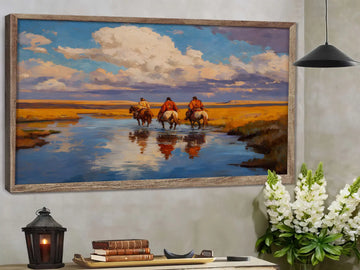In our increasingly fast-paced world, finding moments of peace and serenity within our own homes has become more important than ever. We seek havens that soothe our senses, quiet our minds, and connect us to something deeper than the daily grind. While many elements contribute to a calming environment, the power of art, particularly river-side Native art, stands out as a profound and effective tool for cultivating tranquility.
Imagine walking into a room and feeling an immediate sense of calm wash over you. The air feels lighter, your breath deepens, and the incessant chatter of your mind begins to dissipate. This isn't just wishful thinking; it's the tangible effect that thoughtfully chosen art can have on a space and its inhabitants. And when that art depicts the gentle flow of a river, the vibrant life it sustains, and the deep cultural connections it represents, the calming influence is amplified exponentially.
This comprehensive guide will delve into the profound reasons why river-side Native art possesses such a unique ability to calm the room and the mind. We'll explore the psychological benefits of nature-inspired imagery, the cultural significance embedded within these artworks, and practical ways to integrate them into your home to create a sanctuary of peace.
The Inherent Calm of Water: A Universal Soother
From the rhythmic crash of ocean waves to the gentle ripple of a still lake, water has an innate ability to captivate and calm us. Scientists and psychologists have long recognized the therapeutic effects of being near water, a phenomenon often referred to as "blue mind." This concept suggests that being in, on, or near water can put us in a mild meditative state, reducing stress and increasing feelings of happiness and well-being.
River-side art harnesses this power by bringing the essence of water into your indoor environment. Even a visual representation can evoke the same calming neural responses as being physically present by a river.
Psychological Benefits of Water Imagery:
-
Stress Reduction: The sight of flowing water, even in an artistic depiction, can lower cortisol levels, the body's primary stress hormone.
-
Improved Mood: Water scenes are often associated with peace and tranquility, triggering positive emotional responses and reducing feelings of anxiety.
-
Enhanced Focus and Creativity: The gentle, non-threatening stimulation of water can help clear the mind, making space for clearer thought and creative inspiration.
-
Connection to Nature: In an increasingly urbanized world, art depicting natural scenes serves as a vital bridge to the natural world, fulfilling our innate need for biophilia – the human tendency to connect with nature and other living systems.
When you hang a piece of river-side Native art, you're not just decorating a wall; you're inviting the profound, ancient wisdom of water's tranquility into your daily life.
The Cultural Resonance: More Than Just a Scene
What sets river-side Native art apart from other nature-inspired pieces is its deep cultural resonance and narrative power. For Indigenous communities around the world, rivers are not merely bodies of water; they are arteries of life, sacred pathways, sources of sustenance, and spiritual anchors. They represent continuity, journeys, gathering places, and the interconnectedness of all living things.
Native art depicting rivers often tells stories – stories of survival, tradition, community, and reverence for the natural world. This narrative depth adds another layer to its calming effect. It invites contemplation, curiosity, and a sense of connection to a rich heritage that honors harmony with nature.
Elements of Cultural Significance:
-
Community and Gathering: Rivers have always been central to Indigenous communities, serving as places for fishing, hunting, transportation, and social gathering. Art often reflects these communal aspects, fostering a sense of belonging and warmth.
-
Spiritual Connection: Many Indigenous cultures view rivers as sacred, inhabited by spirits, or embodying spiritual journeys. This imbues the art with a profound sense of respect and awe, encouraging a similar reflective state in the viewer.
-
Sustenance and Life: Rivers provide food, water, and resources essential for survival. Depictions of fishing, hunting, or cultivating lands by the river celebrate this life-giving power and the gratitude associated with it.
-
Journey and Transformation: The constant flow of a river can symbolize life's journey, the passage of time, and the continuous cycles of nature and personal growth.
When you bring a piece like 'Tribal Family by River with Horses' into your home, you're not just admiring a beautiful scene; you're connecting with centuries of wisdom and a deep reverence for the natural world. This connection itself is incredibly calming and grounding.
The Aesthetic Appeal: Harmonizing Your Space
Beyond the psychological and cultural layers, river-side Native art offers immense aesthetic value that contributes to a harmonious and calming environment. The colors, compositions, and artistic styles often found in these pieces naturally lend themselves to creating serene spaces.
Key Aesthetic Elements:
-
Earthy Color Palettes: Many pieces utilize natural hues – blues, greens, browns, and ochres – that are inherently soothing and reminiscent of the natural world. These colors promote relaxation and reduce visual clutter.
-
Organic Forms and Flow: The depiction of rivers, trees, and landscapes features soft, organic lines and flowing compositions, which are visually less jarring than sharp, angular designs. This natural flow contributes to a sense of ease.
-
Balance and Harmony: Native art often employs principles of balance and harmony, reflecting the Indigenous worldview of living in equilibrium with nature. This creates a visually stable and pleasing composition that calms the eye.
-
Textural Richness (even in print): While a canvas print doesn't have physical texture, the visual representation of water ripples, tree bark, and animal fur can evoke a sense of tactile richness, engaging the senses in a gentle way.
Consider a piece like 'Riders Crossing River Decor' in a modern living space. The vibrant yet natural colors, combined with the dynamic yet harmonious scene, can instantly become a focal point that grounds the room and draws the eye into a tranquil narrative.
Integrating River-Side Native Art into Your Home: Creating a Sanctuary
Now that we understand the profound impact of river-side Native art, let's explore practical ways to incorporate it into your home to maximize its calming effects. The key is thoughtful placement and mindful selection.
1. Choosing the Right Piece:
-
Size Matters: A large canvas, such as a prominent piece over a sofa or bed, can become an immersive focal point, dominating the visual field with its calming imagery. Smaller prints can be integrated into gallery walls or placed in intimate nooks for personal reflection.
-
Color Palette: Consider the existing colors in your room. While many river-side pieces feature natural tones, some might have bolder accents. Choose art that complements your current decor without clashing.
-
Subject Matter: Do you prefer active scenes like 'Riders Crossing River Decor' or more contemplative ones like 'Fishing Village Canvas'? Both have calming effects, but the specific mood might vary. Think about the feeling you want to evoke.
-
Artistic Style: Native art encompasses a wide range of styles, from realistic depictions to more abstract or symbolic representations. Choose a style that resonates with your personal aesthetic.
2. Strategic Placement:
-
Living Room Focal Point: A large river-side canvas makes an excellent focal point above a sofa, fireplace, or media console. It draws the eye and immediately establishes a serene atmosphere.
-
Bedroom Sanctuary: Placing river art in the bedroom can promote relaxation and prepare the mind for restful sleep. A piece that evokes peace and dreams, like a gentle river scene, is ideal.
-
Entryway Welcome: Greet guests with a sense of calm and connection by placing river-side art in your entryway. It sets a tranquil tone for the entire home.
-
Office/Workspace: Counteract the stresses of work by incorporating a river-side piece into your home office. It can serve as a mental escape, promoting focus and reducing digital fatigue.
-
Meditation or Reading Nook: Create a dedicated space for mindfulness or reading with a river-side print. The imagery will enhance your contemplative practice.
3. Complementary Decor:
-
Natural Materials: Pair your river-side art with other natural elements like wood furniture, woven rugs, linen textiles, and live plants to amplify the biophilic effect.
-
Soft Lighting: Use warm, dimmable lighting to create a cozy and inviting ambiance that enhances the peacefulness of the artwork.
-
Minimalism: Avoid clutter. Let the art breathe and be the star. A clean and organized space naturally feels more calming.
-
Earthy Tones: Continue the natural color palette in your surrounding decor to create a cohesive and harmonious environment.
Beyond the Visual: The Story of Connection
The calming power of river-side Native art extends beyond its visual appeal and psychological benefits; it also fosters a deeper connection – a connection to heritage, to the environment, and to the continuous flow of life.
Consider the narrative behind a collection like 'We Are Circle – Family & Community Canvas'. These artworks, while depicting a communal scene by the river, embodie the essence of "earth connection art." It speaks to the fundamental human need for community, for shared stories, and for a bond with the land and its resources. This type of art acts as a gentle reminder of our place within a larger ecosystem, encouraging a sense of humility, respect, and belonging – all of which contribute to a profound inner calm.
By choosing authentic or culturally inspired river-side Native art, you are also making a conscious choice to honor and support the traditions and stories of Indigenous peoples. This ethical consideration can further enhance the positive energy and calming presence of the art in your home. It moves beyond mere decoration to become a statement of values and a source of meaningful reflection.
The Ripple Effect: Extending Tranquility Beyond Your Walls
The calming effect of river-side Native art isn't confined to your home; it can extend to your personal well-being and even to the wider world. When you choose to adorn your walls with art that speaks of peace, nature, and cultural depth, you are consciously cultivating an environment that supports your mental and emotional health. This internal tranquility can then ripple outwards, influencing your interactions, your outlook, and your overall quality of life.
Furthermore, many artists and retailers who specialize in Native-inspired art are committed to ethical practices, often giving back to Indigenous communities or supporting environmental initiatives. Your purchase can become a part of a larger positive current, adding another layer of meaning and purpose to your decor choices.
Bring the sound of still water to your wall. Choose a river-side canvas and let your space exhale.
In a world clamoring for our attention, let your home be a quiet harbor. Let the timeless beauty and profound stories woven into river-side Native art be the gentle current that carries away your worries and replenishes your spirit. Each brushstroke, each color, each narrative element contributes to an atmosphere of peace, connection, and deep cultural appreciation.
One item equals one tree planted. By making a conscious choice to bring this meaningful art into your life, you're not only investing in your own well-being but also contributing to the health of our planet, extending the calming ripple effect far beyond your immediate surroundings. Choose a river-side canvas and let your home become a testament to tranquility, connection, and mindful living.







